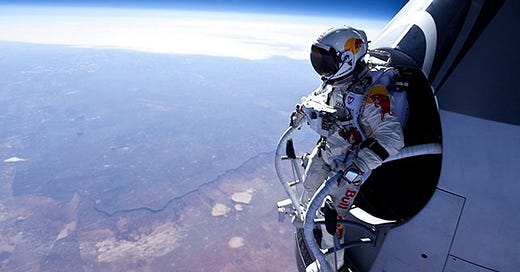How Red Bull got its Wings
By the end of 2023, the global energy drink industry will be worth around $104.39 billion, and sitting on top of the caffeinated throne is Red Bull, which in 2021 alone sold more than 9.8 billion cans across 172 countries – more than one can for every person on the planet!
October 14th, 2012 – millions of viewers watched as skydiver Felix Baumgartner ascended to the edge of space, took a small step, and then free fell about 120,000 feet down to earth. During his descent, he broke the sound barrier and world records. However, this spectacle was not from NASA or Space X as one might assume, but rather that of Red Bull. This is just one of the countless examples of Red Bull’s extreme and unorthodox marketing strategies. In the past, they have been responsible for 10-story motorcycle jumps, snowboarding down an active volcano, and multiple racing, football, and E-Sports teams.
So how did this simple energy drink, which started as an obscure medical syrup, become not only one of the biggest disrupters in the beverage industry but also one of the best-marketed products ever?
HISTORY
In the summer of 1982, the Austrian businessman Dietrich Mateschitz suffered from jet lag during a business trip to Thailand. He tried a local drink called Krating Daeng, which improved his condition substantially. Inspired by the magical qualities of the product, Mateschitz decided to bring the product home in the format of a brand-new product category- the energy drink.
Mateschitz was well aware that there was no market at that time. So he decided to create one. He invested half a million dollars along with Chaleo Yoovidhya for the company. Next, Mateschitz adapted the formula and flavor for the European market and successfully launched the product in Austria in 1987. Red Bull sold over a million cans in their first year. It quickly spread across Europe from Austria, first to Slovakia and Hungary in 1992 and then to Germany and the UK in 1994. When they entered the US market three years later, Red Bull sold over a million cans daily.
MARKETING/STRATEGIES
OUTSOURCING
Mateschitz created a new species of a corporation that focused only on the downstream activities of the value chain while outsourcing operations such as production and logistics. So, it means that Red Bull itself does not produce the drink.
Production and filling of the cans are completely outsourced, so Red bull can fully commit its resources to sell the drink.
One of Red Bull’s secrets to success is that it can charge a much higher price than its competitors. The reason people are willing to pay so much for sugar water with taurine is Red Bull’s brand power. The production cost is $0.09 and the suggested retail price for a can is $ 3.59. Their biggest customers like Walmart and big grocery stores pay between $ 44 and $ 48 per case of 24 cans. That means $ 1.87 per can, which is more than 20 times the cost of production.
BRAND MANAGERS
Mateschitz first focused on the club scene to create a market for his product. The company used ‘student brand managers’ who were encouraged to promote Red Bull on university campuses and to throw parties at different locations, supplied entirely by Red Bull.
Volkswagen Beetles with larger-than-life Red Bull cans strapped to their backs showed up at beaches, colleges, gyms, and even office buildings with free samples. Bartenders quickly learned that this drink was a money machine, and they used to mix Red Bull with vodka or jager, and it became two of the most popular drinks in bars everywhere. The beverage was sold at nightclubs and festivals around the world.
SPONSORSHIP AND OWNERSHIP
Through the sponsorship and ownership of sports teams, Red Bull continuously engages with the customer in a more profound manner than traditional advertising ever could. This allows its customers to feel active and intense by drinking from a can with the same logo as a Formula 1 car, a skateboard, and a record-breaking parachute. Instead of sober storytelling, Red Bull employs story-performing.
They don’t do conventional marketing or look for stories to be associated with. They create their own stories and produce the content with their own media house -> they hold the rights to all pictures of their events. With social media, this results in viral communication effects that drastically improve the return on marketing.
Both sponsoring extreme sporting events and selling with an edge enable Red Bull to remain the market leader in its category. In 2019, they sold 7.5 billion cans, which helped create over $ 6 billion in revenue. To reach that target, they spend almost a third on marketing.
CONCLUSION
Despite the huge marketing budget, Red Bull's revenue growth has slowed down since 2012. The company depends almost entirely on one product which is the energy drink.
This limits its growth and can eventually become a considerable risk. Especially with growing health and nutrition awareness, focusing on a product that causes obesity, insomnia, and diabetes might eventually backfire. Investments in sports teams and media production are therefore not only marketing activities but attempts to diversify and create additional value chains next to the can business. To implement sport as a business, Red Bull takes advantage of a fully integrated entertainment and media value chain that ranges from media production to team ownership and broadcasting.
The football team, Red Bull New York, is an excellent example of how private equity in sports can generate value for Red Bull. They purchased the team for an estimated $ 25 million in 2016. According to Forbes, the team is now worth $ 290 million
-Pragyan Nath







